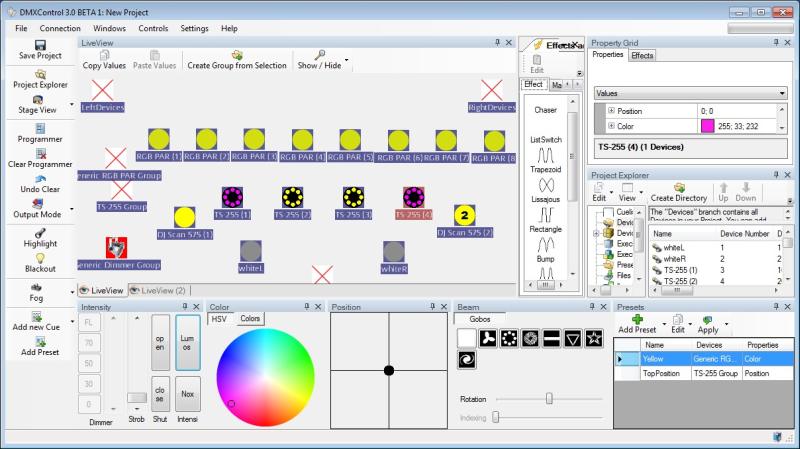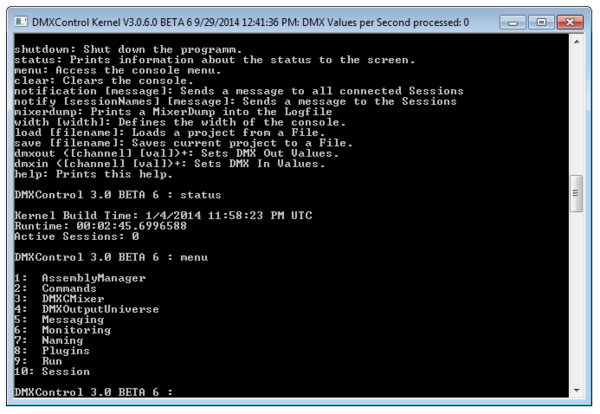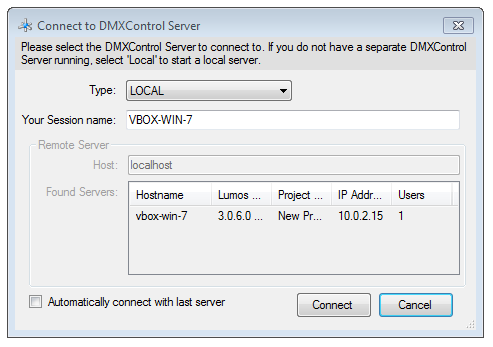Template:Hauptüberschrift Template:NavigationTop-Tut3
{{#tree:id=dmxc3|openlevels=1|root=DMXC 3 lessons|
- preamble
- lesson 1: Installation and configuration
- lesson 2: The GUI panel concept
- lesson 3: Creating and patching fixtures
- lesson 4: The live view panel
- lesson 5: Setting properties with property panels
- lesson 6: Output plugins
- lesson 7: Summery and details - Setting
- lesson 8: Scenes (cues) and scene lists
- lesson 9: Fanning, chasers and other effects
- lesson 10: The programmer view
- lesson 11: Trigger concepts
- lesson 12: Editing scenes and scenelists
- lesson 13: Presets
- lesson 14: Summary and details - Programming
- lesson 15: Working with parallel scene lists
- lesson 16: Softpult
- lesson 17: Artnet
- lesson 18: Multi-media: Beamer tool, Matrix etc.
- lesson 19: Other clients and plugins (Android, iOS, ...
- lesson 20: Create new device definitions
- lesson 21: free topic
- lesson 22: Hints for testers and test reporting
- appendix1: Summary of commands ans shortcuts
- appendix2: Kernel menu tree
}}
Overview
Because of changed operating concept compared to DMXControl 2 a fundamental rethink in the use of DMXControl 3 is necessary. These lessons will help you to become familiar with this concept and provide the skills necessary on the basic characteristics of the new user interface. Here at the beginning a preview as a taste of what awaits you:
Template:Bild mit Unterschrift
This lecture introduces into the distributed architecture of DMXControl 3.0. You will learn some facts about the client and server communication and how to operate the kernel.
Lecture: Installation and Configuration
You can install DMXControl 3 by help of a setup wizard. It verifies that the required software is installed on the PC (see below) and offers to install it if necessary. Optionally, as with the installation of DMXControl 2 EasyView can be selected.
DMXControl 3.0 provides a distributed architecture, i.e. there is a server that can communicate with several clients. The server (hereinafter referred to as kernel) manages all information related to the project. The kernel runs basically on Windows operating system, but can also be launched on Linux (with Mono).
The client is a Windows program. The client provides the interface between the server and the user. One or more clients can run on several systems (PCs) in parallel. Thus, you can work in teams for implementing and performing your show. DMXControl 3.0 supports also cooperation during the life cycle, i.e. you can execute scene lists during your mate is still programming the missing cues!
The separation of the server and the client brings the following benefits:
- the kernel continues in case of malfunction in the user interface and continues DMX output
- several users can share the kernel to work in a team
- kernel and user interface could run on different computers
The kernel
At first, lets start the kernel, i.e. the DMXControl server. Currently this application is called "DMXControl 3 Kernel" or "Lumos.exe" (hint: in the beta version you have to start the kernel as administrator when you have used the standard installation). In future a default user don't have to be aware about the kernel process. It will be automatically started with DMXControl and is (hopefully) continuously running.
During launching the kernel you can observe what is loaded by DMXControl. The kernel is the central master of all information about devices, cues, projects etc. that can be accessed by the clients. And it provides the DMX mixer engine and output system.
The kernel provides a command shell. By typing "help" you get an overview about all supported commands.
Here are a few command line options to get more detailed information about the status of the kernel: *shutdown: Ends the kernel
- status: Displays status information
- menu: menu-access control?
- clear: Clears the console
- xxx notification: Sends a notification to all clients
- xxx width: Specifies the width of the console fixed (number of characters)
- xxx load: Loading a project
- xxx save: Saves the current project
- dmxout [channel, val] +: Sets DMX Out Values
- DMXin [channel, val] +: Sets DMX In Values
- help: help menu (also accessible via '?')
For further details see Appendix 3.
The client
In the next step you should start the Windows-based user interface (currently called "DMXControl 3 GUI" or LumosGUI.exe"), which is located in the subfolder "GUI" in the program directory. This client is explained in more detail in the next lessons. First, however, the communication between kernel and client is initiated automatically. You can also select the Menu Connection-->Connect in order to connect with the server. When you start the client a connection window opens.
If you have installed a firewall you have to grant the communication between client and server.
After establishing the connection you should see a small blue icon in the lower line of the DMXControl main window indicating the existing connection. A red cross indicates that the connection failed. A click on the icon will open the Connection window.
Now you are able to load your project. DMXControl will provide a default demo project. You can open it with menue point File ->Open Project".
| |
If you program the "Lumos.exe" when running the parameter "-nonetwork" are relaying, the kernel will boot automatically mitgestartet a client and connected directly to the kernel. This is you and you avoid the manual and connect the system to the start ready to go. From the Start menu when you install a link is generated that passes these parameters at startup. The link is called "DMXControl 3". |
Project Management
You can save a project as a default project. If you use File -> New Project, DMXControl will load your default project, which can be a project you already patched your fixtures. To save a project as a default project, goto File -> Save Project as, type the name "DefaultProject" and save it to the ressources folder of the kernel "\path\to\your\DMXControl 3.0\Kernel\Ressources\". All project files are archived in a zip-file.
The name of current project is indicated in the top line of DMXControl window.
Excercise
1) Please try following commands in command shell:
- menue
- status
- shutdown -> uups!
2) Restart kernel and GUI and connect your client ("DMXControl 3 GUI") with DMXControl server.
3) Try it: Shut up your DMXControl GUI by task manager and start again: The kernel continues running.
Congratulation! Now you have successfully installed your own DMXControl configuration!
Assumptions for installation
DMXControl 3.0 requires following software to be installed:
- DirectX 9.0c
- .NET Framework 3.5 SP1 or higher
- XNA Framework 3.0(xnafx30_redist.msi)
Additional links and references
- DirectX 9.0c
- .NET Framework 3.5
- .NET Framework 3.5 Service Pack 1
- XNA Framework 3.0 (Has to be installed even if a higher version of XNA framework is already installed)
Certificate
I have understood the topics of this lecture and want to continue with next course: Lesson 2



